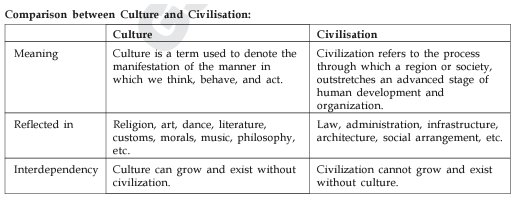


Instruction:
- There will be 2 questions carrying the First Question is-10 marks Write your answers in 150 words and the Second Question is-15 marks Write your answers in 250 words.
- Any page left blank in the answer-book must be crossed out clearly.
- Evaluated Copy will be re-uploaded on the same thread after 2 days of uploading the copy.
- Discussion of the question and one to one answer improvement session of evaluated copies will be conducted through Google Meet with concerned faculty. You will be informed via mail or SMS for the discussion.
Question #1. Culture Complex and its constituent. 10 marks (150 words)
Question #2. What is Culture? What are the characteristics of culture? How does it differ from the concept of civilization? 15 marks (250 words)
(Examiner will pay special attention to the candidate's grasp of his/her material, its relevance to the subject chosen, and to his/ her ability to think constructively and to present his/her ideas concisely, logically and effectively).
STEPS & INSTRUCTIONS for uploading the answers
Step 1 - The Question for the day is provided below these instructions. It will be available at 7:00 AM.
Step 2 - Uploading of Answers : Write the answer in A4 Sheet leaving proper margins for comments and feedback and upload the PDF in MY ACCOUNT section. Click on the option of SUBMIT COPY to upload the PDF.
Step 3 - Deadline for Uploading Answers: The students shall upload their answers by 7:00 PM in the evening same day. The first 50 copies will be evaluated.
Step 4 - Feedback : Mentors will give their feedback for the answers uploaded. For more personalised feedback, join our telegram channel by clicking on the link https://t.me/mains_answer_writing_cse . A one-to-one session will be conducted with the faculty after copy evaluation in 72 Hrs.
Model Answer
Question #1. Culture Complex and its constituent. 10 marks (150 words)
Approach
- Introduce the culture traits and historical background.
- Thinkers Perspective on Culture Trait & Cultural Complex.
- Explanation and example of Cultural Complex.
- Nature of Culture.
- Recent Examples of Cultural trait.
- Criticism of Cultural & Cultural trait.
- Conclusion
Hints:
Introduction:
Traits are the smallest elements of a culture. There are many cultural traits in every culture. Each culture has certain components or traits like a ritual, celebration of different festivals, etc. which distinguish one culture from the other. Even touching feet, shaking hands, taking a particular diet, and wearing a saree are all cultural traits. When cultural traits combine together, they produce a cultural complex.
Thinkers’ Perspective on Culture traits & Cultural complex
- Majumdar and Madan (2008) say that a culture complex is not an institution but is the outcome of the interaction between several institutions. They are defined as the pattern of the interrelation of cultural traits.
- Kroeber has defined cultural traits as the minimal definable element of culture.
- E.B. Tylor in his book Primitive Culture in 1871. He stated Culture is a complex whole that includes knowledge, belief, art, morals, law, customs, and any capabilities and habits acquired by man as a member of society.
- Malinowski defined culture as an instrumental reality and apparatus for the satisfaction of biological and derived needs.
- It is the integral whole consisting of implements in consumers’ goods, constitutional characters for the various social groupings, human ideas and crafts, beliefs, and customs.
- Harris 1975: A culture is a total socially acquired life-way or lifestyle of a group of people.
- Sutherland et al. (1961) say that kawa drinking is observed among the Samoans which is a cultural trait the Samoans. But it is not only about drinking the non-alcoholic beverage but there are rituals of preparing and serving the beverage, pouring out the first cup as a libation to the Gods, there is also ceremonial precedence of serving the kawa and the mythological belief in the background of the ceremony. So, the kawa drinking is tied with many other aspects of the Samoan.
- In this way, the kawa drinking is related to many other traits making it the kawa complex. When similar cultural traits are found in a particular area it is called a culture area.
- For example, the different regions in India like The North-Eastern states, the states like Kashmir, and Tamil Nadu constitute cultural areas.
- It consists of the patterned, repetitive ways of thinking, feeling, and acting that are characteristic of the members of a particular society or segment of society.
Cultural Complex
- Cultural complexity is one of the most commonly used variables in cross-cultural research. When cultural traits combine together, they produce a cultural complex.
- It has often been used as a measure of cultural evolution and has been shown to correlate with numerous other variables.
- At least eight measures of cultural complexity have been constructed since the late 1940s. Several traits when organized together make a culture complex.
- A watch, football match, attitudes and actions, prayer, Hajj, Eids, agriculture system, market system, a political party, a constitution, an industrial unit, and an examination system are examples of culture complex.
Elements of Culture
Language:
For example, in the Arab world in which people depend on camels, there are 3,000 words for camels. Similarly, when we describe vegetables like Drumstick, bitter gourd, etc in Indian words we don’t use any adjectives. But the English words reflect the taste or appearance of these vegetables (Abhraham, 2006). Language and culture are intertwined.
Beliefs:
For example, many people in India believe in God and many auspicious occasions like marriage are scheduled on the basis of auspicious dates. Even marriages are fixed when the horoscopes of the bride and the groom matches.
Norms:
For example, in every society, there are norms governing dressing patterns. On particular occasions, we tend to wear a particular kind of dress. We wear different dresses when we go to a party, a funeral, an office or even a hospital. But norms vary from society to society. For example, in a tribal society wearing a particular dress is acceptable but in other societies, it is not.
Values:
For example, paying attention when the national anthem is played, and respecting elders is a values in the Indian society. Different cultures have different value systems. The American value system is different from the Indian value system. Certain values are also given importance in culture over others.
Schaefer and Lamm (1999) give the example of Papua culture in which contributing to the public good is much more valuable than making a personal profit.
Erasov and Singh (2006) mention families, relatives, older generation as values forming basis of cultural criteria.
Sanctions:
Sanctions are penalties and rewards for the social conduct of a person. Sanctions can be both positive and negative. Conformity to a norm prescribes positive sanctions like rewards, praise, etc. On the other hand, violation of a norm attracts negative sanctions like fines, imprisonment, etc.
Schaefer and Lamm (1999) say that the norms and sanctions in culture reflect that culture’s values and priorities The most cherished values will be the most heavily sanctioned, and the less critical matters will have light sanctions.
Recent examples of Cultural Traits Some cultural traits are followed in India:
- Greetings
- Religious Customs
- Festivals of India
- Family Structure & Marriage
- Symbols • Cuisine & Food
- Traditional Clothing
- Dances of India
- Epics & Mythology
- Martial Arts
- Languages
Conclusion Traits are the smallest elements of a culture. There are many cultural traits in every culture. Each culture has certain components or traits like a ritual, celebration of different festivals, etc which distinguish one culture from the other. Cultural traits combined together, produce a cultural complex.
Question #2. What is Culture? What are the characteristics of culture? How does it differ from the concept of civilization? 15 marks (250 words)
Approach
- A brief introduction to Culture
- Thinker's views on Culture
- Characteristics of Culture
- Associated concept of Civilization and the anthropological approach to civilization
- Conclude the topic with a recent approach.
Hints:
Introduction:
Culture is designed for living. It is the basis of human life. It rests on biology but is not biological. Culture is a historically created design for living. Generation after generation new things are added to it, which is accountable for the development and change in culture. The culture we have at present combines what has been first created by our ancestors with what has been added to it by subsequent generations.
Thinkers Perspective:
- E.B. Tylor in his book Primitive Culture in 1871. He stated Culture is a complex whole that includes knowledge, belief, art, morals, law, customs, and any capabilities and habits acquired by man as a member of society.
- As per Kluckhohn and Kelly (1945), Culture in general as a descriptive concept means the accumulated treasury of human creation like books, paintings, buildings, and ways of adjusting to our surroundings.
- Mc Grew (1998) observed that non-human primates engage in social activities that show human culture’s basic characteristics.
- According to Malinowski, culture is wider concept than society and it includes social organisation of social structure of people.
- Further, He says that culture comes before existence of society.
- Radcliff Brown said that society concerns with social, interpersonal and intergroup relations while culture is an overall design and prescription for a great variety of human behaviour.
- While elements of sociability can be traced to sub-human species, culture is exclusively a human prerogative.
Characteristics of Culture:
- Culture is acquired through social life. The human being is a social animal and has a culture of its own. Culture is shaped by our social interaction and is bound up with social relations within the members of a group.
- Culture regulates the behaviour of the members of a group and fulfils man’s needs like hunger, shelter, clothing etc.
- For Clyde Kluckhohn Culture is a design for living. Culture is defined as a social adjustment or the means by which man adjusts to his environment
- Culture is learned and shared
- Culture is a behaviour acquired by the man from his birth and as a member of society. When a human baby is born, it is helpless. It does not have the pattern of behaviour that is required for living in society or culture is not innate. The baby learns the behaviour and culture of the elders and is socialized to become a member of society.
- In course of time, man becomes human by acquiring the culture of a particular society and is thus called a culture-bearing animal. The influence of culture on human beings is hence deeprooted. After a man learns a culture, culture is internalized and is shared by the members of the group. Culture is shared through communication and cooperation by the members of society.
- Culture is transmitted
- Culture is handed down from one generation to the other and also between nations and people within the lifetime. Culture is what we receive from previous generations and subsequently adapt to. • Culture is transmitted to humans by parents, teachers, and friends through traditions, customs, etc.
- Cultural transmission is different from the genetic transmission. One has no control over genetic transmission such as skin color, hair and color of eyes but through culture man acquires the habits, thoughts, attitudes of his or her parents and through this it is transmitted to the group.
- Ralph Linton (ibid.) appropriately says that culture is the way of life of the members of society. It is the collection of ideas and habits which they learn, share and transmit from generation to generation.
- Culture is symbolic
- A symbol is something on which some value is bestowed by us or it has a meaning. The meaning of symbols is a matter of cultural intervention. For example, the National Flag is not any piece of cloth but has a culture.
- Similarly, to the Christians the cross is a symbol of salvation.
- Culture is dynamic
- It is no longer seen as static, natural, well-bounded and independent of political power.
- Culture is constantly undergoing change and often adapts to external forces. It also undergoes internal adaptation and change.
- Various parts of culture are integrated with each other to constitute a whole.
Concept of Civilization:
Civilization is the stage of human social development and organization which is considered the most advanced. Civilization is also defined as any complex society characterized by urban development, social stratification imposed by a cultural elite, symbolic systems of communication and a perceived separation from and domination over the natural environment.
The anthropological approach to civilization:
Comprehending the concept of civilization in contrast to culture. Two ways of concern with civilization:
- Meaning of civilization Civilization is a stage in the development of human culture. It is concerned with:
- Material Culture and its products
- Trends in technologies
- Creation of equipment to add comfort and luxury
- It is referred to as an external outfit, a sort of cover of technological trends around which people of different cultures organize their lifestyles.
- Content of civilization
- The theory of material and non-material cultures gave rise to the distinction of culture and civilization.
- According to McIver: civilization is what we possess materials aspect and culture is what we are in terms of values, non-materialistic achievements-subjective aspect.
- Civilization is something objective and culture by large refers to differences in values and attitudes etc
Conclusion: There are various approaches to the study of Indian culture and civilization. The culture reflects the richness and diversity of Indian culture and civilization. It is based on the principle of unity in diversity. As per Ember’s understanding of the unity of Indian civilization. We observed India as representing two realities: that of various regions and the unifying ideology of Brahmanical tradition and external intrusions.



